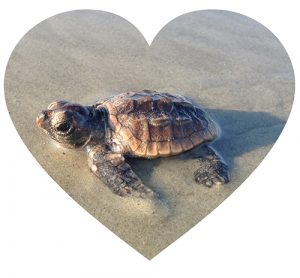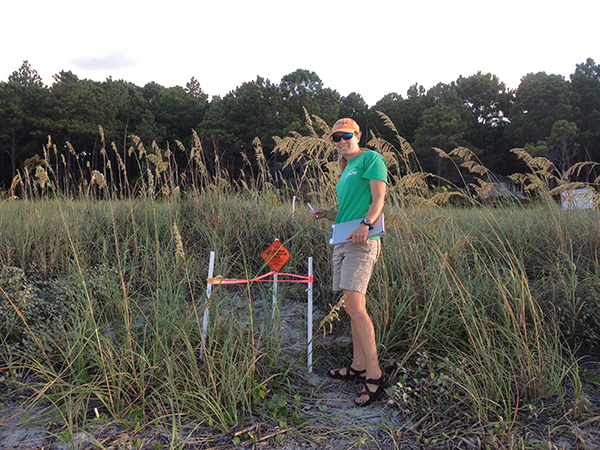You rarely hear about sea turtles nesting on Daufuskie Island, just across the Calibogue Sound.

Their beach is about four miles long, and so close that the sea turtle patrol staff on the south end of Hilton Head can wave at the sea turtle patrol staff on Daufuskie.
In 2016, Daufuskie added 98 loggerhead nests to South Carolina’s total count of 6,444 sea turtle nests. This was approximately equivalent to the nesting density on Hilton Head Island, which was 411 nests on 14 miles of beach. The nest monitoring permit holder on Daufuskie Island is Tammy Helmuth, and she has 12 volunteers who share the duties of monitoring the beach for sea turtle nests. These volunteers fund their own project needs—supplying poles to mark the nests, gas for the four-wheeler, buckets, latex gloves, etc. Sea turtle nest monitoring officially began in 2006 on Daufuskie, but I’m sure it occurred “unofficially” for quite some time.
Hilton Head Island was in the process of building up the beach (dredging offshore sandbars to replenish sand) when Hurricane Matthew made landfall October 2016.
The section of beach most adversely affected was four miles of shoreline in Sea Pines NOT scheduled for beach renourishment.
Daufuskie Island’s beach was already experiencing erosion, but since the storm many nesting areas have washed away. The last beach renourishment on Daufuskie occurred in December of 1998. The Daufuskie Turtle Patrol staff must check the tide each morning before venturing onto the beach because at high tide, some areas are impassable.

The Daufuskie team relocates nests them to higher ground for their protection. On this relatively small stretch of beach, there are still issues with beachfront lighting and disorientation of hatchlings.
Turtle hatching season begins in July.
Melrose Resort (beachfront on Daufuskie) had more activity in the past that would have offended sea turtles, much like Coligny Beach on Hilton Head. Beachfront lighting and noise discourage a female sea turtle from nesting and confuse hatchlings emerging from the sand. Hatchling sea turtles follow the brightest light visible at night when leaving the nest. Naturally, they use the glow of the moon over the ocean as their cue. Artificial light is always brighter than moonglow, causing hatchlings to move away from the ocean and toward commercial and residential exterior lights. Thankfully, beachfront lighting from the resort will be less of an issue this season.
All sea turtle monitoring programs on South Carolina beaches are volunteer efforts, with the exception of the Hilton Head Island Sea Turtle Protection Project. Funding can be sparse at times for these volunteer programs. Spartina Marine Education Charters donated decals for the nest marker poles on Daufuskie Island, and some supplies are provided by the South Carolina Department of Natural Resources.
If you have visited Daufuskie Island, you know that it is a special place.
There are no traffic lights and hardly any cars. Homes range from one-room shanties on dirt roads to fine homes with paved streets in Haig Point. If you have ever had the privilege of being on the Island at night, you will feel like you are on a camping trip and got lost in the woods…a hard experience to find these days. I love it! It is so close, yet feels so far away, and is only accessible by boat.

To those people who give their time for the conservation of wildlife, I commend you. This effort would not be possible if the participants did not have a respect for nature that surpasses fatigue. I know this from personal experience. It is a labor of love.
Known as the “Turtle Lady,” Amber Kuehn is a fourth-generation Blufftonian and marine biologist.
“I went to graduate school for a Master’s in Marine Biology with a focus on sea turtles. It was not the most unprofitable field available, but I have never once regretted my choice,” she says.
Her thesis was a study on the “sea finding” of hatchlings in an urban environment, conducted in Fort Lauderdale, Florida. Beachfront lighting disrupts natural cues for hatchlings finding their way to the sea, as floodlights overwhelm the glow of the moon and hatchlings head towards the brightest light. I
n 2015, Hilton Head Island lost 21 nests due to beachfront lighting. Thanks to a LIGHTS OUT campaign designed by Kuehn, only seven nests were lost as a result of beachfront lighting in 2016. She regards the improvement a step in the right direction, but not a victory. Each nest has approximately 120 hatchlings emerging together and dashing for the ocean in the dark. It is a three-day journey from our islands to the Gulf Stream, and the turtles have just enough energy to make it there.
In addition to the nest monitoring effort, Kuehn coordinates the dolphin and sea turtle stranding response in Beaufort County.
She is authorized to perform necropsies on dolphins, collecting their tissue for analysis by NOAA. She transports sick and injured sea turtles to the South Carolina Aquarium in Charleston and documents deceased sea turtles. All of this effort is volunteer.
“You really have to love it to stick with it,” she notes. And she has stuck with it for almost two decades.
By Amber Hester Kuehn, Marine Biologist, Owner of Spartina Marine Education Charters
For local sea turtle nesting news, visit seaturtle.org. To learn more about The Spartina Dolphin and Sea Turtle Stranding Response Fund or to schedule a “Voyage of Discovery” with Spartina Marine Education Charters, call (843) 338-2716 or visit spartinacharters.com.


